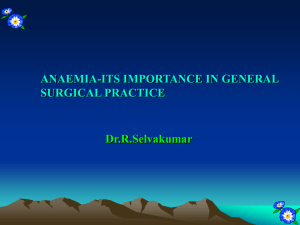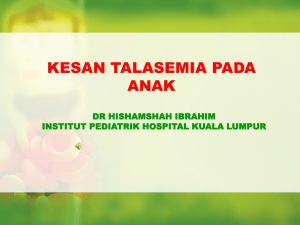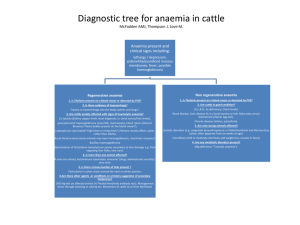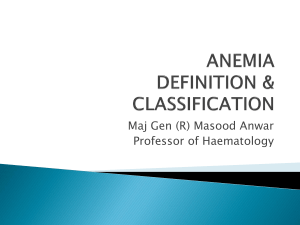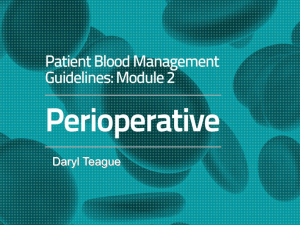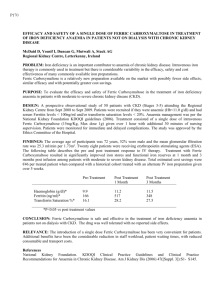Anaemia
advertisement
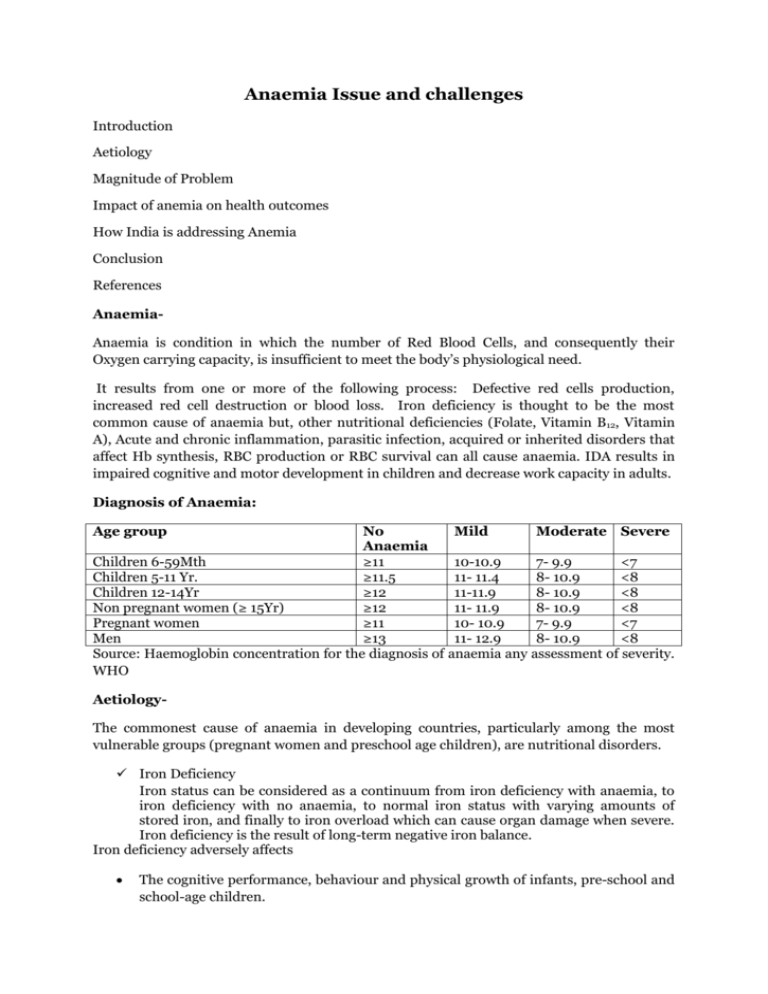
Anaemia Issue and challenges Introduction Aetiology Magnitude of Problem Impact of anemia on health outcomes How India is addressing Anemia Conclusion References AnaemiaAnaemia is condition in which the number of Red Blood Cells, and consequently their Oxygen carrying capacity, is insufficient to meet the body’s physiological need. It results from one or more of the following process: Defective red cells production, increased red cell destruction or blood loss. Iron deficiency is thought to be the most common cause of anaemia but, other nutritional deficiencies (Folate, Vitamin B12, Vitamin A), Acute and chronic inflammation, parasitic infection, acquired or inherited disorders that affect Hb synthesis, RBC production or RBC survival can all cause anaemia. IDA results in impaired cognitive and motor development in children and decrease work capacity in adults. Diagnosis of Anaemia: Age group No Mild Moderate Severe Anaemia Children 6-59Mth ≥11 10-10.9 7- 9.9 <7 Children 5-11 Yr. ≥11.5 11- 11.4 8- 10.9 <8 Children 12-14Yr ≥12 11-11.9 8- 10.9 <8 Non pregnant women (≥ 15Yr) ≥12 11- 11.9 8- 10.9 <8 Pregnant women ≥11 10- 10.9 7- 9.9 <7 Men ≥13 11- 12.9 8- 10.9 <8 Source: Haemoglobin concentration for the diagnosis of anaemia any assessment of severity. WHO AetiologyThe commonest cause of anaemia in developing countries, particularly among the most vulnerable groups (pregnant women and preschool age children), are nutritional disorders. Iron Deficiency Iron status can be considered as a continuum from iron deficiency with anaemia, to iron deficiency with no anaemia, to normal iron status with varying amounts of stored iron, and finally to iron overload which can cause organ damage when severe. Iron deficiency is the result of long-term negative iron balance. Iron deficiency adversely affects The cognitive performance, behaviour and physical growth of infants, pre-school and school-age children. The immune status and morbidity from infections of all age groups. Physical capacity and work performance of all age groups Iron requirements are highest for pregnant women –1.9 mg/1,000 Kcal of dietary energy in the second trimester and 2.7 mg/1,000 Kcal in the third trimester. These are followed by iron requirements in infants (1.0 mg), adolescent girls (0.8 mg), adolescent boys (0.6 mg), nonpregnant women (0.6 mg), preschool and school age children (0.4 mg), and adult men (0.3 mg). Iron deficiency is a consequence of: Decrease Iron intake Increase Iron loss from body Increase Iron requirement Iron requirements increase during the period of active growth in childhood, from 6 months to 3 years. In infancy, iron deficiency is most often the result of lack of exclusive breast feeding and use of unsupplemented milk diets which contain inadequate amounts of iron. Milk products are very poor sources of iron and prolonged breast or bottle feeding of the infant without complementary feeds after 6 months of age frequently lead to iron deficiency unless there is iron supplementation. Iron requirements are proportionately greater in premature and underweight babies. In older children, a predominantly milk and cereal based diet and food fads can also lead to IDA. Blood loss during menstruation and increased iron requirements during pregnancy and lactation predispose women to poor iron stores. Other micronutrient deficiencies Vit B12 deficiency leads to Megaloblastic anaemia. Diets with little/no animal protein, coupled with malabsorption related to parasitic infections of small intestine, might result in Vit B12 deficiency & anaemia. Folic acid is also essential for the formation and maturation of RBC's and is also necessary for cell growth and repair. Deficiency of follate reduces the rate of DNA synthesis; this shortens the lifespan of circulating RBC, & results in Anaemia. Helminthic infection Hookworm(Ancylostoma duodenalae) and flukes (Fasciola Hepatica- liver fluke)cause chronic blood loss and consequently iron loss from the body, resulting in the development of anaemia. A hookworm burden of 40–160 worms(depending on the iron status of the host) is associated with IDA. Malaria Causes anaemia by rupturing RBCs and suppressing production of RBCs. Decreased RBC production results from marrow hypoplasia seen in acute infection. Plasmodium falciparum is the primary cause of severe malaria in regions where malaria is endemic. Malarial anaemia can cause severe morbidity and mortality especially in children and pregnant women infected with Plasmodium falciparum. Malaria in pregnancy increases the risk of maternal anaemia, stillbirth, spontaneous abortion, LBW and neonatal deaths. Sickle cell disease(SCD) and Thalassemia It SCD is among the most common genetic diseases in the world and results in recurrent haemolytic anaemia. Thalassemia is one of the major haemoglobinopathies in the world, is caused due to decreased or negligible amount of globin chain of haemoglobin. About 10 per cent of the world’s thalassemia patients belong to the Indian subcontinent and 3.4 per cent of them are carriers. In India, about 32,400 infants are born with haemoglobinopathies every year. Infections Certain chronic diseases, such as cancer, HIV/AIDS, rheumatoid arthritis, Crohn’s disease and other chronic inflammatory diseases, can interfere with the production of RBCs, resulting in chronic anaemia. Kidney failure can also cause anaemia. Problem Statement: The WHO Global Database on Anaemia for 1993–2005, estimated the prevalence of anaemia worldwide at 25 per cent. Although the prevalence of anaemia is estimated at 9 per cent in countries with high development, in countries with low development the prevalence is 43 per cent. In absolute numbers anaemia affects 1.62 billion people globally. Children and women of reproductive age are most at risk, with global anaemia prevalence estimates of 47 per cent in children younger than 5 years, 42 per cent in pregnant women, and 30 per cent in non-pregnant women aged 15–49 years. Africa and Asia account for more than 85 per cent of the absolute anaemia burden in high-risk groups and India is the worst hit. Anaemia contribute to more than 115,000 maternal deaths and 591,000 perinatal deaths globally per year. Analysis of data on global prevalence shows that anaemia is disproportionately concentrated in low socioeconomic groups, and that maternal anaemia is strongly associated with child anaemia. South-East Asia Region: Table2: Prevalence of Anaemia in India and neighbouring countries (SEA Region ) Country Proportion of population with Public Health problem Anaemia (Hb<11gm/dl) Bangladesh 47.0 Severe Bhutan 80.6 Severe India 74.3 Severe Nepal 78.0 Severe Pakistan 50.9 Severe Sri Lanka 29.9 Severe Source: WHO Global Database on Anaemia India: India is one of the countries with very high prevalence of anaemia in the world. Almost 58 per cent of pregnant women in India are anaemic and it is estimated that anaemia is the underlying cause for 20–40 per cent of maternal deaths in India The National Family Health Survey-3 (NFHS-3) data suggests that anaemia is widely prevalent among all age groups, and is particularly high among the most vulnerable – nearly 58 per cent among pregnant women, 50 per cent among non-pregnant non-lactating women, 56 per cent among adolescent girls (15–19 years), 30 per cent among adolescent boys and around 80 per cent among children under 3 years of age. Table3: Prevalence of Anaemia among different age groups Age group Prevalence of Anaemia(%) Children (6-35 months) 79 Children (6-59 months) 69.5 All women (15-49 years) 55.3 Pregnant women (15-49 Years) 58.7 Lactating women (15-49 Years) 63.2 Adolescent Girls 12-14 Years 68.6* 15-17 Years 69.7* 15- 19 Years 55.8 Source: NFHS 3 *National Nutrition Monitoring Bureau Survey (NNMBS), 2006 Trends in anaemia prevalence Anaemia prevalence in U-5 Children Seven out of every 10 children aged 6-59 months in India are anemic -3 per cent are severely anaemic, 40 per cent are moderately anaemic, and 26 per cent are mildly anaemic. More than half of young children in 24 states have anaemia, including 11 states where more than two thirds of children are anaemic. The prevalence of anaemia has actually increased from NFHS-2 to NFHS-3. The percentage of children with any anaemia increased from 74.3 per cent in NFHS-2 to 78.9 per cent in NFHS-3 (Graph1). In the period between the two surveys, there was an increase in the prevalence of mild anaemia (from 23% to 26%) and moderate anaemia (from 46% to 49%). Graph 1: Prevalence of anemia among children 6-35mth (%) 100 80 60 Mild 40 Mod 20 Sev Any 0 Urban Rural NFHS-2 Total Urban Rural NFHS-3 Source: NFHS-2, NFHS-3 Prevalence of anaemia among adolescent girls and boys Total Graph2: Prevalence of anemia among Adolescent girls (12-19 Yr) and young women (20-29Yr) 80 70 60 50 40 30 20 10 0 68.6 55.8 56.1 39.1 38.5 27 20.5 14.9 16 1.1 1.7 1.7 12-14 Yr 15-19Yr 20-29 Yr 12-14 Yr 15-19Yr 20-29 Yr 12-14 Yr 15-19Yr 20-29 Yr 12-14 Yr 15-19Yr 20-29 Yr Any Mild Moderate severe Source: NFHS-3, NNMBS 2006 Prevalence of anaemia among pregnant women, men and women of reproductive Age: Anaemia is a major health problem for adults as well, affecting 55 per cent of women, 58 per cent of pregnant women and 24 per cent of men. The prevalence of anaemia among ever married women increased from 52 per cent in NFHS-2 to 56 per cent in NFHS-3 Graph4: Prevalence of anemia among pregnant women 70 58 60 50 Percentage 40 30 26 31 20 10 2 0 Mild Moderate Severe Any Source: NFHS-3, 2005-06 Impact of Anaemia on Health Outcomes: Anaemia has major consequences on human health as well as social and economic development. Anaemia is the world’s second leading cause of disability and is responsible for about 1 million deaths a year, of which three-quarters occur in Africa and South-eastAsia and responsible for2.4 per cent of the total DALYs worldwide. Physical and cognitive losses due to IDA cost up to 4.05 per cent loss in gross domestic product (GDP) per annum for developing countries while 1.18 per cent of GDP in India. Children who suffer from anaemia have delayed psychomotor development and impaired performance; in addition, they experience impaired coordination of language and motor skills, equivalent to a 5–10 point deficit in intelligence quotient. Worldwide, it is estimated that about 20 per cent of maternal deaths are caused by anaemia; in addition, anaemia contributes partly to 50 per cent of all maternal deaths. First, anaemia reduces women’s energy and capacity for work and can therefore threaten household food security and income. Second, severe anaemia in pregnancy impairs oxygen delivery to the foetus and interferes with normal intra-uterine growth, resulting in intrauterine growth retardation, stillbirth, LBW and neonatal deaths. Therefore, anaemia is a major contributor to poor pregnancy and birth outcomes in developing countries as it predisposes to premature delivery, increased perinatal mortality and increased risk of death during delivery and postpartum. How India is addressing AnaemiaA study group on nutritional anaemia of the Nutrition Society of India recommended in 1968 an anaemia prophylaxis programme for the eradication of anaemia of pregnancy and childhood16. According to this Expert Group, the most practical and expeditious way of doing this is to give supplements of iron and folate to anaemic pregnant woman during the last 100 days of pregnancy. Based on the results of controlled supplementary trials then available and theoretical computations, the Group recommended 60 mg of elemental iron in the form of ferrous compound and 500 µg of folic acid. They recommended at least 50 percent of all pregnant women to be covered during the first five years. They suggested the use of PHC, the subcentre and MCH Centres as outlets for the distribution of tablets. They also gave a plan for distribution of tablets and their quality control. They also emphasised the educational component to motivate the women and periodic evaluation of the impact of the programme. In pursuance of the above recommendations, the GoI had set up the National Anaemia Prophylaxis Programme (NAPP) in 1970 in all States of the country. The target population under this programme comprise pregnant women, lactating women, family planning acceptor women (of terminal methods and I.U.D.s) and children of both sexes between one and 11 years (both years inclusive). The supplementation provided under this programme consists of tablets of iron folate containing 60 mg of elemental iron (ferrous sulphate) and 500 p.gfolic acid for all adult woman beneficiaries. For children smaller tablets containing 20 mg elemental iron (FeS04) and 100 µg folate are provided. For children who cannot swallow tablets, iron and folic acid in the same dose as in single tablet is given in 2 ml of syrupy liquid. Each beneficiary is given one tablet daily for a period of 100 days once a year for every year of his/her beneficiary status. With due course of time (after >15 years), no improvement in anemia prevalence was discernible, as several studies7,8 conducted this period indicated. One reason that was strongly advanced was that the dose of iron given to pregnant women was insufficient and there were proposals to increase the dose to 120 or 240 mg/day based on a study in India9. An evaluation of the programme in 11 states of the country, conducted by the ICMR during 1985-865 yielded the following depressing conclusions10: The programme has not made any significant impact on the prevalence of anaemia. The important drawback of the programme was that a large proportion of the women did not receive the tablets due to poor supply of tablets to PHC. The monitoring of supply of tablets and their distribution as well as compliance were far below the desired level. There were also the problems of the poor quality of the tablets. Apparently the programme has remained all these years as a "low priority" programme! Another aspect of the programme which has not been highlighted is adequacy of production of folifer tablets and the availability of chemicals. Arising from the evaluation, certain recommendations for the improvement of the programme have been made Recommendations of the lCMR Task Force on Evaluation of NAAP 1. All the pregnant women to be covered, since there are no simple methods of identifying anaemics. 2. Education of the health functionaries involved in implementation of the programme at all levels. 3. Periodic checking of the quality of tablets. 4. Pilot study to find out the best strategy for delivery of the supplement. 5. Ensuring adequate and regular supply of the supplement at the PHC level. 6. Ensuring the quality of tablets with regard to its contents as well as the coating. 7. A rationalised fixing of targets in different states based on population statistics. 8. To consider alternate strategies as additional measures to control nutritional anaemic. But surprisingly nothing has been said about the dosage of Iron, as by that time many studies recommended to increase the dose of Iron in pregnant women from 60mg to at least by 120mg. In 1990, Dr B S Narsinga Rao (Former Director of NIN Hyderabad) suggested “Iron dosage to anaemic pregnant women should be 120 mg/day. It could be delivered as a single tablet or two tablets of 60 mg each,by which side effects can be reduced. There is also a need to improve the appearance of the tablet viz. the changeover from brown to red colour. Better linkages between the ICDS and the health system could facilitate wider coverage. While medicinal iron supplementation to selected groups at risk is important, the need to augment dietary intake of iron must be recognised as this is the obvious logical approach”8. A National Nutrition Policy was adopted in 1993, with the objective of operationalizing multi-sectoral strategies to address the problem of under-nutrition/malnutrition. Based on this, the National Plan of Action on Nutrition 1995 laid out the sectoral Plan of Action for 14 Ministries and Departments of the Government of India. A National Nutrition Mission has been set up to address nutrition issues through a mission mode approach under the oversight of the Ministry of Women & Child Development (MWCD). One of the Goals for the 12th five year plan is to reduce anemia in girls and women by 50 percent. (This was one of the goals in 9th (1997-2002), 10th (2002-2007),11th FYP(20072012), and 12th FYP(2012-2017) also. Efforts to Control Anemia among Children and pregnent women in India(After 1990) As anemia has continued to be highly prevalent among children, the program has been redesignated as the National Nutritional Anemia Control Program in 1991. This program aims at decreasing the incidence of anemia among the vulnerable sections of the population, namely pregnant and lactating women, intrauterine device (IUD) users, and children in the one-to-five year age group. The program is envisaged to be implemented as part of the RCH II package now and was being implemented through the existing health system and Integrated Childhood Development Scheme (ICDS) run by the Department of Women and Child Development. Studies suggested that iron and folic acid (IFA) tablets given to young children under the age of three years is not well-accepted and efforts have been made to recommend that liquid IFA be replaced by IFA tablets for young children. This recommendation has been endorsed in the Government of India's policy in the year 2007, and it further endorses the requirement of iron supplementation to children below one year of age as well. NNMB (2003) documented that children had anemia prevalence as high as 67%, with 43% having moderate-to-severe anemia12. High anemia prevalence documented by the studies and surveys such as the NNMB, and the lack of monitoring are indicators from the routing management information systems, which speak of the actual state of the program that is in total disarray at the implementation level12. Issues in management of anemia WHO strongly advocate that when there is a prevalence of anemia above 40%, a universal supplementation is required and it is not cost-effective to screen children for anemia. However, clinically speaking, many technical experts believe that to differentiate severe anemia, a screening is desirable. What is important and needs to be emphasized is that universal intervention need not wait until this screening, and that screening is done primarily with the aim of finding children afflicted with severe anemia that may not be corrected with the current program and would need specific treatment. National Iron+ Initiative: 2013 Taking cognizance of ground realities discussed above the Ministry of Health and Family Welfare took a policy decision to develop the National Iron+ Initiative. This initiative will bring together existing programmes (IFA supplementation for: pregnant and lactating women and; children in the age group of 6–60 months) and introduce new age groups. Thus National Iron+ Initiative will reach the following age groups for supplementation or preventive programming: • Bi-weekly iron supplementation for preschool children 6 months to 5 years • Weekly supplementation for children from 1st to 5th grade in Govt. & Govt. Aided schools • Weekly supplementation for out of school children (5–10 years) at Anganwadi Centres • Weekly supplementation for adolescents (10–19 years) • Pregnant and lactating women • Weekly supplementation for women in reproductive age The National Iron+ Initiative also defines a minimums service of packages for treatment and management of anaemia across levels of care. Platforms and services at each level have also been mapped out and service providers’ roles and responsibilities detailed. Since anaemia is not just about medical interventions but to a great degree about behaviour change (both in terms of dietary habits and compliance) an extensive communication campaign will be developed. A conscious effort has already been made under WIFS programme to position the supplementation positively in order to reach out to both boys and girls and ensure compliance. IFA tablet has been made blue‘Iron ki nili goli’) to distinguish it from the red IFA tablet for pregnant and lactating women. The campaign has been built around benefits of IFA supplementation and healthy eating. The scope of this communication campaign will be enhanced to address all target segments. Approach – What Would It Take to Fight Iron Deficiency and IDA More Effectively? Anaemia is a multi-factorial disorder that requires a multi-pronged approach for its prevention and treatment. Iron deficiency and infections are the most prevalent aetiological factors. The benefit-to-cost ratio of iron interventions based on resource savings, improvement in cognitive development and schooling, and physical productivity was estimated to be as high as 200:1. Prevention of both iron deficiency and anaemia require approaches that address all the potential causative factors. Interventions to prevent and correct iron deficiency and IDA, therefore, must include measures to increase iron intake through food-based approaches, namely dietary diversification and food fortification with iron; iron supplementation and improved health services and sanitation Dietary diversification Dietary diversification is encouraging the consumption of micronutrient rich foods – dark green leafy vegetables, lentils and vitamin C rich fruits – which may be available but are underutilised by the deficient population. Food fortification Food fortification refers to the addition of micronutrients to processed foods. In many situations, this strategy can lead to relatively rapid improvements in the micronutrient status of a population, and at a very reasonable cost, especially if advantage can be taken of existing technology and local distribution networks. Supplementation Food supplements are highly concentrated vitamins and minerals produced by pharmaceutical manufacturers in the form of capsules, tablets or injections and administered as part of health care or specific nutrition campaigns. Ministry of Health and Family Welfare’s Revised Strategy In such a scenario, where it is difficult to influence dietary behaviour, the key step towards addressing iron deficiency and IDA would be the implementation and scaling up of the IFA Supplementation programme and management of all forms (mild, moderate and severe) of IDA. The strategy for control and prevention of IDA would be provision of IFA supplementation and therapeutic management of mild, moderate and severe anaemia in the most vulnerable groups – children, adolescents, pregnant and lactating mothers and women. Supplementation through the Life Cycle An anaemia supplementation programme across the life cycle is proposed in which beneficiaries will receive iron and folic acid supplementation irrespective of their iron/Hb status. The age-specific interventions are based on WHO recommendations, synthesis of global evidence on IFA supplementation and the recommendations of national experts Overview of Implementation Modalities forIFA Supplementation for Each Target Segment 1. Supplementation for Children 6–60 months Dose and Regime One ml of IFA syrup containing 20 mg of elemental iron and 100 µg of folic acid biweekly for 100 doses in a year. Iron folic acid supplements will be supplied in bottles of 100 ml each. The bottles should have an auto-dispenser so that only 1 ml of syrup will be dispensed at a time. Albendazole tablets will be provided to children for biannual de-worming as per following schedule Implementation For all children aged 6 to 60 months it is proposed that IFA supplement will be administered under the direct supervision of an Accredited Social Health Activist (ASHA) on fixed days on a biweekly basis. The nutritional status of children should be assessed by MUAC (Mid Upper Arm Circumference less than 11.5 cm) to ensure that IFA syrup is not given to children with Severe Acute Malnutrition (SAM). ASHA would give IFA syrup bottles to mothers for safe storage and to lessen the logistic hurdle of carrying bottles around, but the IFA syrup will be administered under her direct supervision only. Time of administration – half an hour after food if the child has been breastfed /fed semisolid/solid food Benefits of regular intake of IFA syrup in physical and cognitive development of the child e.g. improvement in well-being, attentiveness in studies and intelligence etc. Minor side effects associated with IFA administration such as black discolouration of stools. Preservation of IFA bottle – in a cool and dark place, away from reach of children, keeping the lid of the bottle tightly closed each time after administration, etc. Supplementation for Children 5 (61 months onward)–10 years Dose and Regime Tablets containing 45 mg of elemental iron and 400 mcg of folic acid would be given once a week throughout the 5–10 years period. In addition to IFA supplements, Albendazole (400 mg) tablets for de-worming are to be administered twice a year for anti-helminthic treatment Note: Prophylaxis with iron should be withheld in case of acute illness (fever, acute diarrhoea, pneumonia etc), severe acute malnutrition and in a known case of haemoglobinopathy/history of repeated blood transfusion. Implementation The platform of school and AWC would be utilised to provide IFA supplementation and deworming tablets to children in the age group 5–10 years through involvement of teachers and Anganwadi workers (AWWs). ASHA would be involved in mobilization of these children at community level Other measures to prevent anaemia in children Besides the provision of micronutrient supplements, the following measures need to be taken simultaneously as long-term measures to prevent IDA in children: Promotion of exclusive breastfeeding for the first 6 months of life Appropriate and adequate complementary feeding with iron rich foods till 2 years of age Dietary diversification to include foods rich in absorbable vitamins and minerals Diagnosis and control and treatment of parasitic infections Weekly Iron and Folic Acid Supplementation (WIFS) Programme for Adolescent Girls and Boys (10–19 Years) During this stage the requirement of nutrition and micronutrients is relatively high. Therefore, adolescents, especially girls, particularly those between the ages of 12–15 years, are vulnerable to iron deficiency mainly because requirements are at a peak. For this target segment the following interventions are proposed: Administration of supervised weekly IFA supplementation (100 mg elemental iron and 500 mcg folic acid) throughout the calendar year, i.e., 52 weeks each year Biannual de-worming for helminthic control Screening of target groups for anaemia and referring these cases to an Appropriate health facility Information and counselling for improving dietary intake and for taking action for prevention of intestinal worm infestation Implementation modalities for WIFS Through the platform of Government/Government aided/ municipal schools. WIFS will also reach out-of-school girls in the age group 10–19 years through the platform of Anganwadi Kendras. Pregnant Women and Lactating Mother Through sub-centres, primary health centres (PHCs), community health centres (CHCs) and district hospitals (DHs) to all pregnant women and lactating mothers. Dose and regimen IFA supplementation (100 mg elemental iron and 500 mcg of folic acid) every day for at least 100 days, starting after the first trimester, at 14–16 weeks of gestation followed by the same dose for 100 days in post-partum period. Nutrition counselling is being provided during antenatal/postnatal check-ups and during monthly Village Health & Nutrition Day (VHND) to pregnant women and lactating mothers. In addition to this, all women in the reproductive age group in the pre-conception period and up to the first trimester of the pregnancy are advised to have 400 mcg of folic acid tablets to reduce the incidence of neural tube defects in the foetus. Implementation ASHA to ensure provision of IFA supplements to pregnant women who are not able to come for regular antenatal checkups through home visits. She will also monitor compliance of IFA tablets consumption through weekly house visits Women in Reproductive Age Group (WRA) (15–45 Years) are at increased risk of anaemia because of chronic iron depletion during the menstrual cycle, inadequate dietary intakes and recurrent infections. The intermittent IFA supplementation to all menstruating women would be a cost effective strategy to build up iron stores and prevent anaemia. The following intervention is proposed for them: IFA supplementation (100 mg elemental iron and 500 mcg of folic acid) throughout the calendar year, i.e., 52 weeks, each year Albendazole (400 mg) tablets for biannual de-worming for helminthic control ASHA to distribute IFA supplements to women in reproductive age group during doorstep distribution of contraceptives. Therapeutic Approach through the Life Cycle Six Months – 60 Months ASHAs and ANMs will screen children from 6 months up to 5 years of age for signs of anaemia through opportunistic screening at • VHNDs • Immunisation sessions • House-to-house visits by ASHAs for biweekly IFA supplementation • Sick child coming to health facility (Sub-centre/PHC) Screening through assessment of palmar pallor (as per IMNCI guidelines) Facility level management • Any child reporting to any facility (PHC level and above) with any illness will be assessed clinically by the attending Medical Officer for anaemia routinely and should undergo Hb estimation if found to be anaemic clinically • All children referred from field (community, outreach, sub-centre) to PHC due to palmar pallor will undergo Hb level estimation before initiating treatment. After completion of treatment of anaemia and documenting Hb level >11 gm/dl, the IFA supplementation to be resumed. Treatment of anaemia with iron should be withheld in case of acute illness, Severe Acute Malnutrition and in a known case of haemoglobinopathy. Anaemia in these cases should be treated as per the standard treatment guidelines, by the attending physician, as per the merit of the individual case. Children 5–10 Years Teachers and AWWs respectively will undertake screening for anaemia of in-school and outof-school children in the age group 5–10 years. All children with clinical pallor will be referred to PHC/Mobile Medical teams for Hb estimation and treatment of anaemia. Children undergoing Hb estimation under Universal Screening Programme will also be referred to PHC/FRU/DH according to severity of anaemia for management Facility-level Management Management of anaemia on the basis of haemoglobin levels in children 5–10 years Management of severe anaemia at FRU/DH in children 5–10 years Indications for further investigations and referral for management Adolescents in the Age Group 10–19 Years Screening Screening for anaemia in adolescents will be undertaken by teachers for in-school adolescents and by AWW for out-of-school adolescents by assessment of palmar, nail bed and tongue pallor. Adolescents with clinical pallor will be referred to PHC/Mobile medical teams for Hb testing and treatment. Facility level management of anaemia in adolescents All adolescents referred to PHC with pallor will undergo Hb level estimation before initiation of treatment. Adolescents will be categorised as having mild, moderate and severe anaemia on the basis of Hb levels Pregnant and Lactating Women Screening of all pregnant women for anaemia at sub-centre/VHND/outreach/PHC level can be done by Sahli’s haemoglobinometer or by Standard Hb Colour Scale. Therapeutic dose of oral IFA supplementation can be initiated even on clinical signs and symptoms, however, such cases must be referred for confirmation of degree of anaemia through Hb testing and for further management. Pre-requisites for parenteral therapy • Should be given under proper supervision • After test dose only • Close monitoring required • Inj. Adrenaline, Hydrocortisone and oxygen to be available for management of anaphylactic reactions. • Cardiopulmonary resuscitation facility to be available. • Other indications for parenteral iron therapy are poor compliance or intolerance to oral iron therapy. Post-partum/post-natal period Regime of management of anaemia and dosage for IFA supplementation during postpartum period will depend on the degree of anaemia if this persists (as already given above), based on results of Hb assessment and as advised by the treating doctor. If the woman is nonanaemic in post-partum period, prophylactic regime (1 tablet per day for 100 days) should be given. Compliance • Ensure availability of IFA tablets at all levels • Provision of tablets to pregnant women in time • Regular tracking of pregnant women for ANC checkups including Hb testing and completion of treatment • Counselling of pregnant women on the common side-effects of IFA supplementation, general myths associated with intake of IFA tablets, related risk if anaemia not treated, etc • Provision of incentives to frontline health workforce for completion of treatment resulting in rise of Hb level to normal level Precautions for oral therapy • Intake of doses as per regime, should be taken regularly and must complete the treatment • Ideally, tablets should be taken on empty stomach for better absorption. In case of gastritis, nausea, vomiting etc., advise to take one hour after meal or at night • If constipation occurs, advise to drink more water and add roughage to diet • IFA tablets should not be consumed with tea, coffee, milk or calcium tablets • IFA treatment should always supplemented with diet rich in iron, vitamins (particularly Vitamin C), protein, minerals and other nutrients e.g. green leafy vegetables, whole pulses, jaggery, meat, poultry and fish, fruits and black gram, groundnuts, ragi, whole grains, milk, eggs, meat and nuts, etc. Specific role of ASHA • Preventive IFA supplementation to every pregnant woman • Identification of anaemic women during pregnancy and post-partum period through routine and outreach activities and VHNDs • Bringing these identified women to institutions for diagnosis and treatment • Ensure regular intake of IFA for treatment of anaemia as advised by ANM/MO/ Specialist etc • Ensure follow-up visits by pregnant women at the scheduled time to the health facility/ VHND/outreach activity site • Provide appropriate and supportive care for anaemia • Counselling pregnant women on the common side effects of IFA supplementation, general myths associated with intake of IFA tablets, related risk if anaemia not treated, etc • Dietary counselling of pregnant women (increase intake of iron-rich foods such as green leafy vegetables, whole pulses, jaggery, meat, poultry and fish. Advise to take fruits and vegetables containing vitamin C in diet as these enhance the absorption of iron in the diet, high protein diet, including items such as black gram, groundnuts, ragi, wholegrains, milk, eggs, meat and nuts, etc.) Specific role of ANM • Refer pregnant women to next higher health facility that is equipped to manage complications in pregnancy when: ƒ Hb <8 gm/dl ƒ There is poor compliance or intolerance to oral iron therapy in mild to moderate anaemic pregnant women ƒ Hb level does not rise in spite of taking treatment (IFA tablets in the prescribed dose)for a month Specific role of MO • All mild and moderate anaemic pregnant women to be treated at PHC/CHC and severely anaemic at FRU • Prepare line list of severely anaemic pregnant women and submit it to district CMO • Treatment and follow up of line listed pregnant women • Train and orient ANMs and lady health visitors (LHVs) on the detection and treatment of anaemia and supervise them. Conclusion: It is disheartening, that at the implementation level not much is being done about anemia in most countries. In India, where the program is in place for more than four decades, it is not being implemented at any significant level. The small amount of data that exists regarding the program points to poor implementation. There is also a brighter side to anemia control, So widespread is anemia, particularly in India and South East Asia – that although long awaited, it is now getting the recognition and attention it rightfully deserves. Now, most countries speak of anemia control in their health planning documents. Millennium development goals aimed at the reduction of infant and maternal mortality will have to address anemia as it is a common problem with serious consequences for both these groups. It is therefore recommended that we need to bridge the gap between our desire to control and reduce anemia and our lack of action and apathy toward implementing an effective program in anemia control. We need to emphasize, train, support, and effectively monitor the program's implementation, and systematically and realistically plan out logistics, supply, monitoring, and implementation of the program at the regional, national, state, and district levels. Only then will this curse, that is, anemia, be adequately controlled and the fruits that the program promises will actually be delivered. References: 1. Guideline for Control of Iron Deficiency Anaemia, National Iron+ Initiative. In: Division A, editor. New Delhi: Ministery of Health and Family Welfare, Government of India; 2013. 2. Iron Deficiency Anaemia Assessment, Prevention and Control: A guide for Programme managers. Geneva: World Health Organization; 2001. 3. WHO. Guideline: Daily iron and folic acid supplementation in pregnant women. Geneva, World Health Organization, 2012 4. WHO. Guideline: Intermittent iron and folic acid supplementation in non- anaemic pregnant women. Geneva, World Health Organization, 2012 5. WHO. Guideline: Intermittent iron and folic acid supplementation in menstruating women. Geneva, World Health Organization, 2011 6. WHO. Guideline: Intermittent iron supplementation in preschool and school-age children. Geneva, World Health Organization, 2011 7.Vijayaraghavan K, Brahmam GN, Nair KM, Akbar D, Rao NP. Evaluation of national nutritional anemia prophylaxis programme. Indian journal of pediatrics. 1990 MarApr;57(2):183-90. PubMed PMID: 2246014. 8.http://nutritionfoundationofindia.res.in/pdfs/BulletinArticle/Pages_from_nfi_04_91_2. pdf 9. Sood SK, Ramachandran K, Mathur M, et al. WHO sponsored collaborative studies on nutritional anaemia in India. Q J Med. 1975; 44:241–258. 10. ICMR (1989); Report of a Task Force Studies on the evaluation of National Anaemia Prophylaxis Programme. 11. Kotecha PV, Nutritional Anemia in Young Children with Focus on Asia and India. Indian J Community Med. 2011 Jan-Mar; 36(1): 8-16 12. Hyderabad, India: Indian Council of Medical Research; 2003. NNMB. National Nutrition Monitoring Bureau: Prevalence of Micronutrient Deficiencies: NNMB Technical Report No. 22, National Institute of Nutrition.

